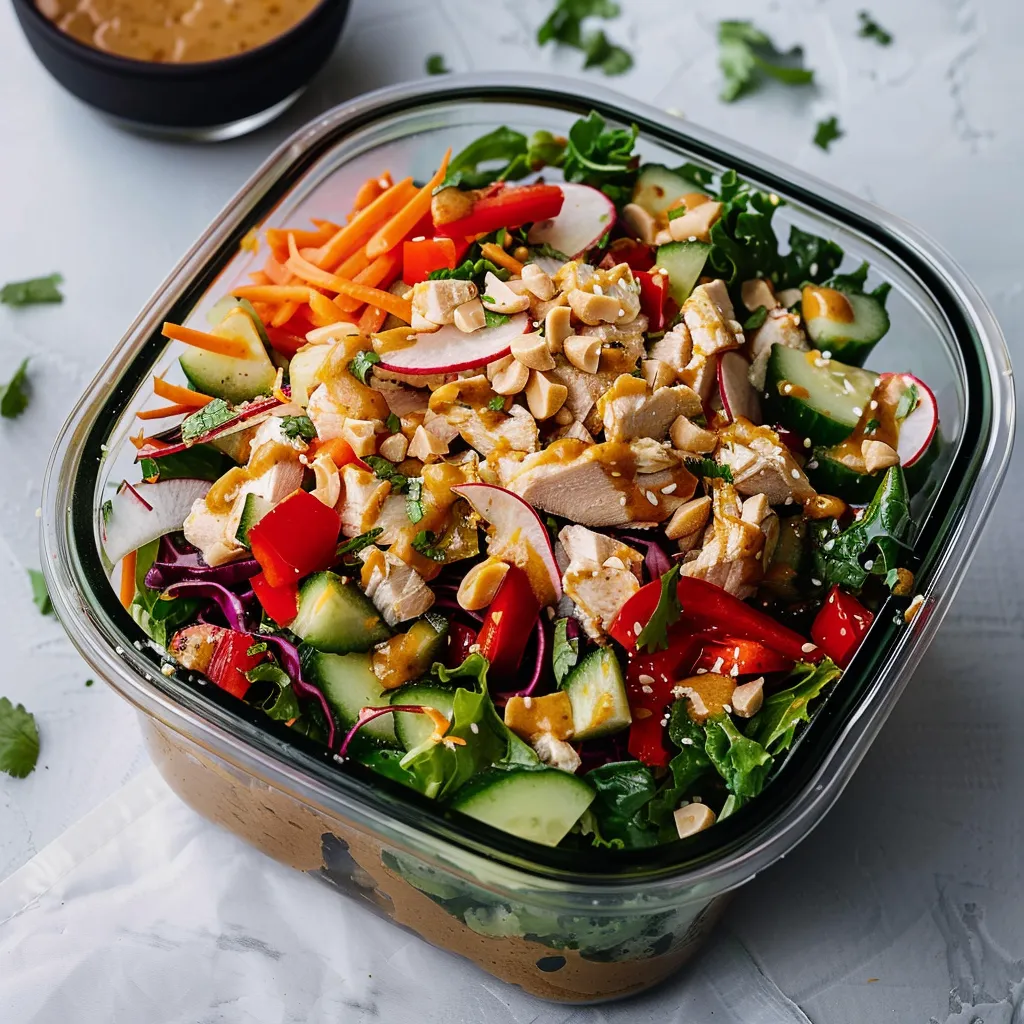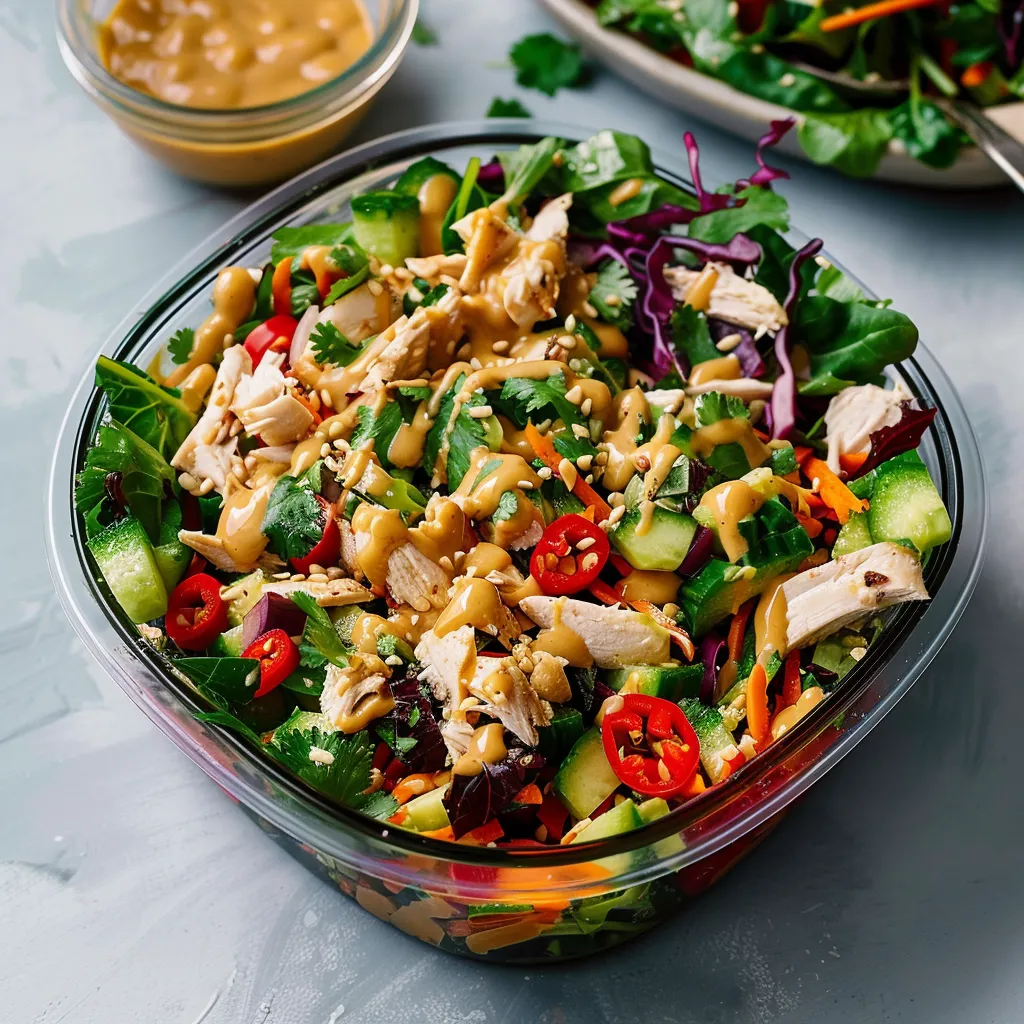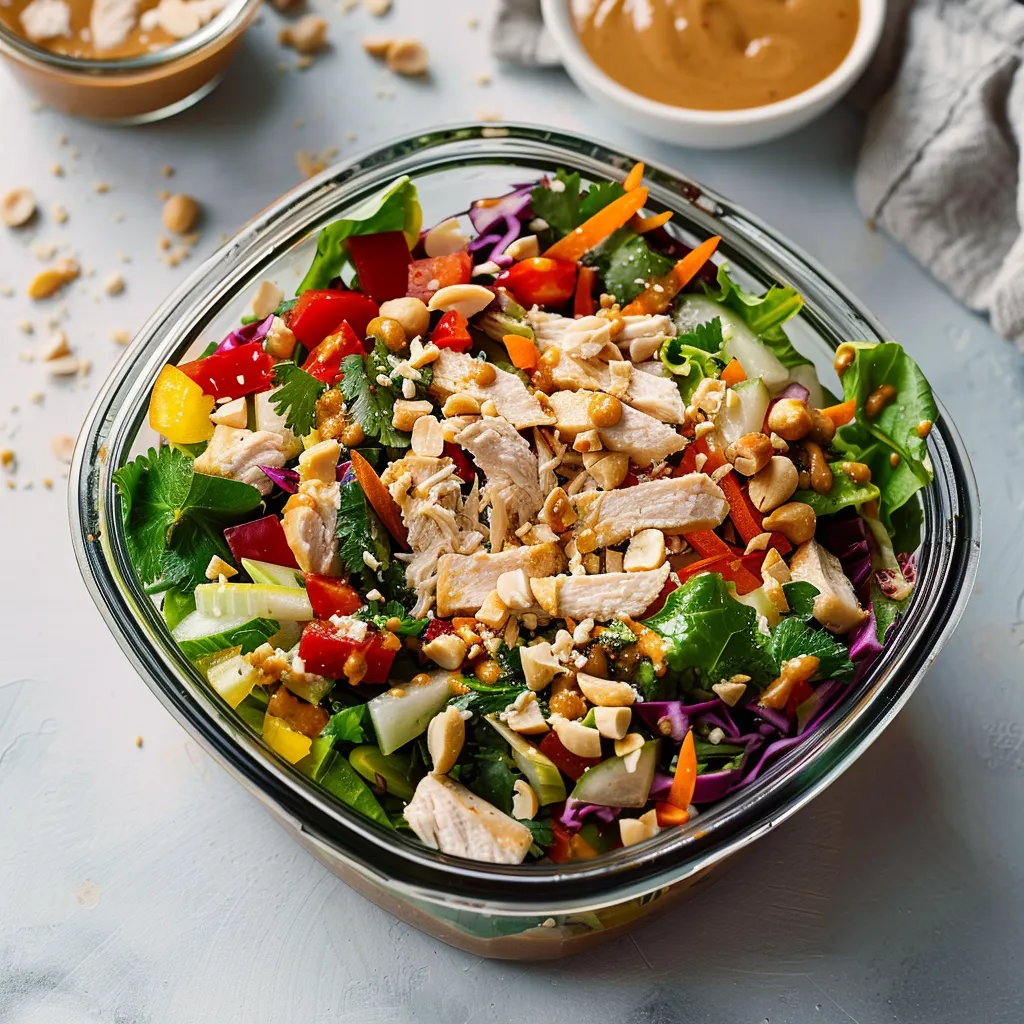 Pin it
Pin it
Bright, crunchy veggies and juicy chicken make up a nutrient-packed spectrum in this irresistible Asian-inspired bowl that tackles both your hunger and wellness aims at once. The true wonder comes when the smooth peanut-lime sauce wraps around each colorful chunk, giving you that ideal mix of sweet, zesty, and rich flavors without messing up your clean eating goals. Great for planning meals ahead, this taste-loaded champion kicks boring lunches to the curb for good.
When I first brought this bowl for my work lunch, I had three teammates instantly wanting the how-to after they spotted and caught a whiff of my bright meal. What began as my own fix for dull lunches soon turned into our team's unofficial hot weather meal planning contest. Even my guy, who usually thinks of salads as 'just bunny food,' asks for this often and feels truly full without grabbing his normal after-lunch snacks.
Vibrant Ingredients
- Pulled chicken: Slim protein that soaks up taste wonderfully
- Ripe mango: Adds natural sweetness and sunny pop
- Snappy cabbage: Forms a crunchy bottom with amazing staying ability
- Bright bell peppers: Bring nutrient-packed crunch and eye-catching flair
- Grated carrots: Give natural sweetness and lovely orange touch
- Cut kale: Nutrient-loaded greens that don't go soft in made-ahead bowls
- Live herbs: Cilantro and basil bring fresh scents throughout
- Crushed peanuts: Add texture change and pleasing snap
- Light peanut sauce: Pulls it all together with can't-resist taste
I found by lucky chance that rubbing the kale briefly with just a tiny bit of oil and salt before mixing in other stuff really makes it better. This quick trick turns sometimes hard kale into soft greens with no bitter taste, making it way more likable for folks who usually skip this super green.
Simple Assembly
- Mix sauce foundation:
- Stir real peanut butter, low-salt soy sauce, honey and fresh lime juice in blender cup.
- Throw in flavor boosters:
- Add crushed garlic, ginger, small hot pepper, and touch of fish sauce for rich flavor.
- Mix until smooth:
- Blend completely, adding water one spoon at a time until you get the right thickness.
- Fix the flavor:
- Try it and tweak sweetness, tang and salt by adding more honey, lime or soy sauce if needed.
- Ready your protein:
- Pull cooked chicken breast into small bits that mix well with other goodies.
- Cut up veggies:
- Slice all vegetables to matching sizes for even bites and pretty looks.
- Build the bottom:
- Mix tougher items like cabbage, kale and carrots in big bowl as your starting point.
- Toss in extras:
- Add bell peppers, mango, herbs and chicken, mixing them all through evenly.
- Split smartly:
- For meal planning, split salad mix evenly into boxes, keeping sauce apart until eating time.
- Last touch:
- Right before you eat, pour on peanut sauce and sprinkle with crushed peanuts for best taste.
 Pin it
Pin it
I found out the hard way that how you put things together really changes how good your salad is and how long it lasts. My first try at meal planning threw everything in one bowl right away, which left me with mushy veggies by day three. Now I smartly stack tougher stuff at the bottom with lighter bits on top, and always keep the sauce totally separate until I'm ready to eat. This easy change in how I do things makes sure everything stays perfect and fresh all week.
Tasty Ways to Enjoy
Put it in a see-through bowl to show off all the pretty colors, or add hot brown rice under the salad for a bigger meal. Set up the parts separately on a big plate for a make-your-own setup at parties.
Easy Swaps
Use crunchy tofu instead of chicken, switch mango for pineapple or persimmons based on what's in season, or toss in some edamame for more protein punch.
Keeping It Fresh
Keep all parts in different sealed boxes up to five days. Save sauce in tiny cups, only adding it when you're about to eat so everything stays crisp.
 Pin it
Pin it
I started making this salad during a tough diet reset when normal healthy food just didn't get me excited anymore. The mix of snappy veggies, soft chicken, sweet mango and that amazing peanut sauce made something that felt like a treat while still helping my health goals. This perfect balance between yummy and good-for-you shows the lasting way of eating that finally helped me keep my beach body all year instead of rushing to get in shape each spring before swimsuit time.
Frequently Asked Questions
- → How long will this salad last in the refrigerator when meal prepped?
- If you keep the sauce apart from the other ingredients, this Thai chicken mix will stay good in the fridge for 4-5 days. The trick is keeping everything separate until you're ready to eat, since the tangy sauce will make your veggies go soft if mixed too early.
- → Can I make this recipe vegetarian or vegan?
- Sure thing! For a plant-based version, swap the chicken with edamame, tofu pieces, or tempeh. In the sauce, use maple syrup or agave instead of honey, and replace fish sauce with extra soy sauce and a squeeze of lime, or try a seaweed-based vegan fish sauce.
- → What can I substitute for the birdseye chili if I can't find it?
- Don't worry if you can't get birdseye chilies. You can use ¼-½ teaspoon red pepper flakes, a small serrano or Thai pepper, or even a squirt of sriracha instead. Start with less and add more to your sauce if you want it spicier.
- → Is there a nut-free alternative for the peanut butter in the dressing?
- For folks who can't have nuts, sunflower seed butter works great instead of peanut butter in the sauce. It's just as creamy and mixes well with everything else. In the salad, try roasted sunflower or pumpkin seeds instead of peanuts for that nice crunch.
- → Can I use different vegetables based on what's in season?
- This salad is super flexible! Feel free to switch up the veggies based on what's fresh or what's in your fridge. Try adding thin cucumber slices, shredded brussels sprouts, edamame, snap peas, or broccoli mix. The sauce tastes good with pretty much any crunchy vegetables you choose.
- → How can I make this salad gluten-free?
- To make a gluten-free version, just swap regular soy sauce for tamari or a certified gluten-free soy sauce. Everything else in the recipe doesn't have gluten naturally, but always look at the labels on store-bought stuff like fish sauce to make sure there's no hidden gluten in there.
